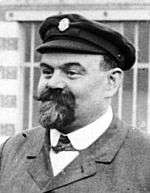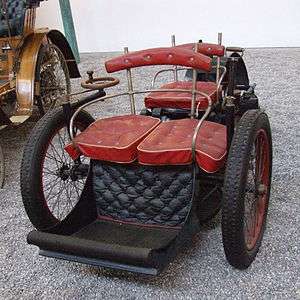Léon Bollée

Léon Bollée (1 April 1870 – 16 December 1913) was a French automobile manufacturer and inventor.
Life



Bollée's family were well known bellfounders and his father, Amédée Bollée (1844–1917), was the major pioneer in the automobile industry who produced several steam cars. Both Léon Bollée and his older brother Amédée-Ernest-Marie (1867–1926) became automobile manufacturers.
Calculating machines
In 1887 Bollée began work on three calculating machines: the Direct Multiplier, the Calculating Board and the Arithmographe. Bollée's Multiplier was the second successful direct-multiplying calculator (the first was Ramón Verea's) and it won a gold medal at the 1889 Paris Exposition. Three versions of the large multiplier and several smaller machines were developed by Bollée and the devices were patented in France, Belgium, Germany, the USA and Hungary.[1]
Steam locomotive
In 1892, his father, Amédée Bollée produced a steam locomotive for the Chemin de Fer du Finistère.
Automobiles
Bollée and his father entered a steam car, La Nouvelle, in the 1895 Paris–Bordeaux–Paris race and Bollée went on to develop a gasoline-powered vehicle in 1895 which was entered in the 1896 Paris–Marseille–Paris.[2]
Car manufacturing
Bollée founded the company Léon Bollée Automobiles in 1895 in Le Mans. In 1896 he patented and began manufacturing the three-wheeled vehicles he had invented in 1895 which he called the Voiturette (which can be translated as autoette). These had a horizontal motor and were equipped, for the first time, with rubber tires. A new model with many modifications was brought to the 1897 Paris-Dieppe race, driven by Paul Jamin,[3] and the Paris-Trouville race and won both events with respective speeds of 24 mph (39 km/h) and 28 mph (45 km/h).[2]
By 1903, Bollée had started producing larger vehicles and soon gained a good reputation for quality. When the Wright brothers visited France to show their aircraft, Bollée let them use his Mans factory.
Léon Bollée was injured in a flying accident in 1911 and never really recovered as he also had a pre-existing heart problem and died in 1913. His widow continued to run the company but in 1922 it was bought by Morris Motors and the company was renamed Morris-Léon Bollée, the intention being to use the new company to sell Morris designs in France and circumvent the then current French import restrictions. Morris sold the company in 1931 to a group of investors who renamed it Societé Nouvelle Léon Bollée and production continued until 1933.
Family
Bollée's daughter Élisabeth, a poet, married the Count Jean Maurice Gilbert de Vautibault in 1927, and later divorced de Vautibault to marry the artist Julien Binford. She died July 11, 1984.
References
- ↑ "Léon Bollée's Arithmographe". IBM. Retrieved 2006-10-05.
- 1 2 "1898 Leon Bollee Tri-Car". Owls Head Transportation Museum. Retrieved 2006-10-05.
- ↑ Official Program, 24 Heures du Mans, 13–14 June 2009, Page 97.
External links
- Picture of Léon Bollée
- 1898 Leon Bollee Tri-Car
- The 'Institut international d'informatique Léon Bollée' of Ho Chi Minh City (Viêt Nam) is named from the French engineer.(French)(Vietnamese)
- Histomobile (French)
Video